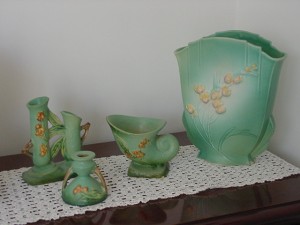A Cure For The Arts and Crafts Blues
March 22nd, 2010 by adminLearn more about New England Antique Shows and their upcoming events by clicking here!
 |
Learn more about New England Antique Shows and their upcoming events by clicking here!
 When it comes to the art of pottery, the name ‘Roseville’ says it all. The Roseville Pottery Company produced some of the most beautiful American Art pottery of the 20th Century. From the simplest utilitarian wares to their artist signed pieces, Roseville is eagerly sought by today’s collectors.
When it comes to the art of pottery, the name ‘Roseville’ says it all. The Roseville Pottery Company produced some of the most beautiful American Art pottery of the 20th Century. From the simplest utilitarian wares to their artist signed pieces, Roseville is eagerly sought by today’s collectors.
The Roseville Pottery Company was incorporated in 1892 by George F. Young. The earliest product was utilitarian stoneware items such as flower pots and umbrella stands. In 1898, the company moved from Roseville Ohio to a larger and more modern facility in Zanesville Ohio – which was well known for its rich clay deposits. It was here that they began producing art pottery, introducing their Rozane line in 1900 to compete with slip-decorated wares being manufactured by Weller and Rookwood.
By the mid teens, market demand was moving away from the expensive hand-crafted art pottery and towards less expensive, mass produced pottery. Roseville’s ability to adapt to the changing trend is what set them apart from their competitors. They easily transitioned from hand made to mass produced lines while still maintaining the artistry of their wares. Patterns like Donatello, Carnelian and Mostique established Roseville’s reputation for ‘art quality commercial pottery’.
But it was in 1919 when Frank Ferrel became art director at Roseville that the company hit its stride. It was under his artistic direction that Roseville began producing the floral patterns and Art Deco designs that have become synonymous with its name. Ferrel collaborated with glaze chemist George Krause to create what are easily the most popular and highly sought patterns that Roseville produced: Sunflower, Futura, Ferella, Cherry Blossom, and Blackberry just to name a few.
It was the success of Ferrel’s Pine Cone pattern that paved the way for the floral patterns of the 1940’s and early 50’s. Introduced in 1930, it was the first pattern to have a Roseville signature incised or in relief on the base. The Pine Cone line included over 75 different shapes in 3 different color combinations. Pine Cone became the most commercially successful line Roseville ever produced, with the highest sales volume of any Roseville pattern.
During the 1930’s and 40’s, Ferrel added at least 2 new floral designs to production each year. Patterns such as Magnolia, Fuchsia, Bleeding Heart, Zephyr Lily and Bittersweet kept Roseville in the forefront of the pottery market. But the end of World War II brought change to the world’s economic climate. After 1945, sales began to decline as foreign imports flooded the pottery market. While Roseville was still the best quality art pottery available at the time, the inexpensive price of these imports became impossible to overcome. In 1952, the company introduced an ovenware line called Raymor, but it was not enough to save them. Roseville Pottery company ceased operations in 1954.
Throughout its 64 year history, Roseville’s versatility and creativeness kept it at the forefront of the art pottery world. To this day, the name ‘Roseville Pottery’ represents some of the finest and most collectible art pottery ever produced.